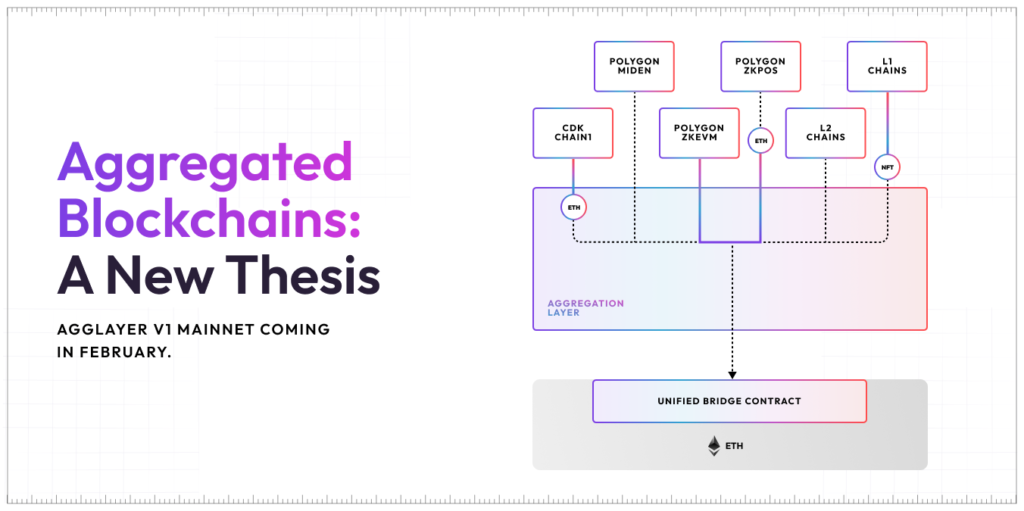-
Polygon plans to bridge with layer 1 blockchains such as Solana to enhance blockchain interoperability and scalability.
-
As an emerging AI altcoin, InQubeta offers a unique crowdfunding platform based on NFTs, attracting significant investor interest.
-
Polygon has introduced the AggLayer interoperability protocol to connect various blockchain networks to Ethereum.
In 2023, Polygon (MATIC) Labs, the developers behind the Ethereum (ETH) scaling solution, unveiled an ambitious plan to serve as the foundational core of the decentralized internet.
Their strategy revolves around creating a network of interconnected blockchains akin to Solana (SOL) that share Ethereum’s security and liquidity features. This move aims to enhance interoperability and scalability across various blockchain ecosystems.
Meanwhile, the emergence of InQubeta (QUBE), an up-and-coming AI (artificial intelligence) altcoin, has attracted considerable attention from analysts. Positioned at the intersection of cryptocurrency and AI, InQubeta offers a unique crowdfunding platform leveraging non-fungible tokens (NFTs).
Polygon Bridges Layer 1 Blockchains for Enhanced Interoperability
As anticipation builds around its official listing on mainstream exchanges, analysts foresee significant potential for the project.
As InQubeta concludes its presale rounds, investor interest continues to soar. The final presale stage presents an opportunity for participants to acquire QUBE tokens at a discounted rate, with analysts projecting a potential 5,000% increase in value upon its launch. The project’s recent presale round has already raised over $13.6 million, indicative of the growing momentum behind InQubeta.
Upon completion of its presale phase, InQubeta aims to establish an ecosystem that facilitates easy ownership of blockchain assets and investment in leading AI startups. Token holders will have access to trending NFTs, seamless trading mechanisms, and opportunities for staking rewards and community engagement through voting rights.
While Polygon initially focused on Ethereum Layer 2 chains, its vision has evolved to encompass broader interoperability goals, including integration with Layer 1 blockchains like Solana.
MATIC co-founder Mihailo Bjelic recently announced Polygon’s AggLayer interoperability protocol, which connects various blockchain networks to Ethereum.
ALSO, READ; Cosmos-Based Canto Blockchain Reverses Course on Polygon Layer-2 Plans, Unveils New Roadmap.
The decision to bridge with layer 1 blockchains reflects its commitment to enhancing connectivity and scalability within the blockchain ecosystem. As smaller layer 1 networks migrate to layer 2 solutions for improved liquidity, its interoperability initiatives offer a compelling value proposition.

Despite the profitability of established layer 1 chains like Solana, the appeal of integrating with Ethereum’s ecosystem remains significant for both developers and investors.
Recent data from a CoinGecko survey highlights Solana’s growing popularity among cryptocurrency investors, with the blockchain accounting for 50% of all blockchains in Q1 2024.
This trend underscores the importance of its efforts to bridge Ethereum with prominent layer 1 networks like Solana, positioning itself as a pivotal player in the evolving landscape of decentralized finance (DeFi).
Ethereum is a cornerstone of blockchain technology, offering a decentralized platform for building various digital applications. Notable for its scalability, programmability, and security features, Ethereum’s native cryptocurrency, ETH, facilitates transactions and incentivizes network participants.
In contrast, Solana emerges as a fast and scalable blockchain platform, boasting high transaction throughput and low fees compared to its counterparts. Founded in 2017, Solana aims to support decentralized applications (dApps) with enhanced speed and efficiency, catering to the growing demand for seamless blockchain experiences.
ALSO, READ: From Polygon to Avalanche: Sports Illustrated Tickets Bold Move in NFT Ticketing.
Its endeavor to bridge Ethereum with layer 1 blockchains carries profound implications for the broader blockchain landscape. By facilitating seamless connectivity between disparate networks, Polygon aims to unlock new possibilities for decentralized finance (DeFi), non-fungible token (NFT) ecosystems, and beyond.
One key area of focus is regulatory compliance. As blockchain adoption accelerates, regulatory scrutiny has intensified, necessitating robust compliance measures. Its interoperability solutions provide a framework for navigating regulatory requirements seamlessly, enabling developers and users to engage confidently.
Moreover, its integration with layer 1 blockchains like Solana augurs well for the broader cryptocurrency market. By fostering greater interoperability, Polygon enhances liquidity and market depth, bolstering the overall ecosystem’s resilience. This interconnectedness reduces fragmentation and improves market efficiency, benefiting participants.
From a technological standpoint, its interoperability initiatives represent a paradigm shift in blockchain architecture. By leveraging layer 2 scaling solutions and interoperability protocols, Polygon enhances the scalability and throughput of Ethereum-based applications, paving the way for mass adoption.
InQubeta’s emergence as a leading AI-focused cryptocurrency underscores the transformative potential of artificial intelligence within the blockchain space. InQubeta aims to revolutionize the finance and healthcare industries by harnessing AI algorithms and blockchain technology.
One area where InQubeta shines is in AI-powered investment strategies. InQubeta analyzes market trends and investor sentiment through sophisticated algorithms and machine learning models to identify lucrative investment opportunities. This data-driven approach empowers users to make informed decisions and maximize investment returns.
Furthermore, InQubeta’s crowdfunding platform allows AI startups to access capital and resources. By tokenizing ownership stakes and leveraging blockchain technology, InQubeta democratizes access to investment opportunities, fostering innovation and entrepreneurship.
Its strategic initiative to bridge Ethereum with layer 1 blockchains like Solana signals a significant step towards enhancing interoperability and scalability in the blockchain ecosystem.
Simultaneously, InQubeta’s emergence as a leading AI-focused cryptocurrency underscores the convergence of blockchain technology and artificial intelligence. As both projects navigate towards their respective milestones, analysts remain optimistic about their potential impact on the evolving landscape of Web3.
